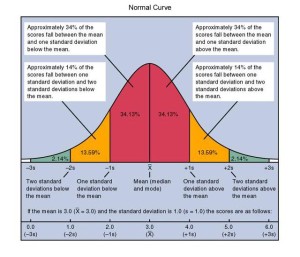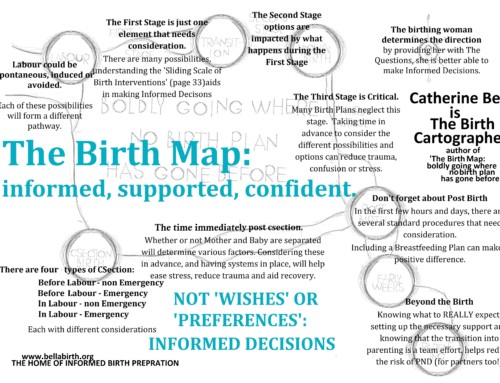By Tracy G. Cassels
“Failure to progress” – a term far too many women have heard during their birthing experience. What does it mean? It means your body isn’t dilating or getting your baby out based on a predetermined schedule. What is this schedule? It’s Friedman’s Curve, and it looks like this:
A depiction of Friedman’s curve, based on data from Friedman, E. A. (1955). “Primigravid labor; a graphicostatistical analysis.” Obstet Gynecol 6(6): 567-589. and Friedman, E. A. (1956). “Labor in multiparas; a graphicostatistical analysis.” Obstet Gynecol 8(6): 691-703. From Evidence Based Birth.
The data is based on 500 labouring women from 1954. There are many, many reasons why the curve itself is out of date and a wonderful article from Evidence Based Birth (found here) on the topic is incredible and in all seriousness, go read it because it’s unbelievably comprehensive. But it misses one thing that I want to add and address: How we think of averages.
Based on Friedman’s curve, the amount of time to reach each stage is as follows:
|
Dilation |
Time to reach (Standard Deviation) |
|
0-4cm |
8.6 hrs (6 hrs) |
Now, although there are lots of reasons to ignore this data completely, what if we don’t? What if we assume we could take 500 women today and get the same results (which we probably wouldn’t for reasons EBB provides)? What does this mean?
Well, if we think of it statistically, the amount of time needed to define failure to progress should be based on the top 5% of births which is the equivalent of a standard deviation of 1.65. Before we calculate it, let’s just remember that birth falls on a normal curve as well which looks like this:
Okay, so for a woman to have not progressed based on being in the top 5%, she would need to have taken 18.5 hours to get to 4cm dilation or 11.5 hours to get from 4 to 10cm dilation or have been pushing for 2.32 hours (a woman at the edge could take 32.32 hours and have it be in the “normal” realm). I don’t know about you, but when a doctor first came in to suggest I wasn’t progressing fast enough during the pushing stage, I’d only been pushing an hour. At an hour, 50% of women will have finished pushing and are hopefully holding their babies. But 50% of women are still pushing. And for those who are told they aren’t progressing after 8 hours of early labour, there’s not a single shred of evidence to suggest that. In fact, based on old data, 40% of women wouldn’t have reached 4cm after 10 hours.
The problem is when people assume that because a number is an average, most people will fall towards that. It’s nothing of the sort. It’s just a mid-point with people falling on both sides equally and sometimes falling rather far away while still being completely normal. When it comes to birth and the potential for problems, we usually err on the side of caution, but if we err too far to the side, we end up with problems, like rocketing c-section rates and the complications that go along with those. Or myriad interventions that aren’t called for.
We need to be very clear when we start throwing around the term “failure to progress” that we should be talking about a very specific limit barring no other problems. It can be serious and a symptom of other complications that need dealing with, but not at the stages a lot of women are being told they’ve hit it. Let’s also not forget the current standards don’t even consider that we need updated data on averages based on current birthing practices (e.g., with and without an epidural, first time versus experienced birthers). And for mothers, if you think you’re going into birth with an “average” total labour and pushing time of 12 hours, think again. You could labour for 3 hours or 32 and still fall in the range of what’s normal.








This is probably THE best blog post about the time that ti takes to give birth I have ever seen! I live in a country, where birth is allowed to progress pretty naturally and with as few interventions as possible. Still, at the end I got some pitocin to speed up the labour. I thought it was fine after 27 hours, especially since my mother, grandmother etc. all had very slow births… I am pretty sure, however, that in the US they would have given me pitocin (or even worse, unnecessary c section) after only 12 h…
You are probably very right – unless you stayed at home before going in for a long enough period. Once you go to the hospital, you’re on their clock 🙁 It’s such a shame!
This post makes some good points. The meaning of average is often misconstrued in many fields. However, GGH — not counting early labor, which went on for a couple of days — I was in active labor for 92 hours at a hospital in the US and no one used the phrase ‘failure to progress’ or suggested pitocin. The US is a very large country with a variety of attitudes about birth. Also, a lot of hospitals (including the one where I birthed) are seeking a ‘baby friendly hospital’ certification and natural births help their numbers.
I laboured 28 hours on my first and the only talk of speeding things up was in relation to monitoring my blood pressure. I’ll say thst the team at the dublin national maternity hospital were fantastic. I was lucky that 4 cm to baby in arms only an hour though.
I labored for a week. I dilated very slowly, about 1-1.5 cm a day for a few days. I was finally admitted after four days (at a 6 ish) but my labor slowed, and eventually regressed, from the stress of being bugged every thirty minutes to have my water broken, pitocin, etc. I was lucky enough to end up having my daughter at home with a midwife that weekend, but it’s very normal to labor even more than 32 hours, even though my OB and NP had never seen it in all of their years of practice, combined. There needs to be more wonderful information like this out there so women can learn that 12 hours is just one of the many possible lengths of labor! Thank you for all of the wonderful information you share on this site.